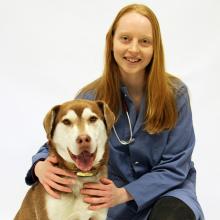During this hot, dry summer in Midwestern Ontario, I’ve been thinking about how various animal species adapt to warmer temperatures. During the summer months, it seems fitting to consider how we can best care for our pets and livestock so they stay cool and comfortable.
Dogs are our faithful companions come rain, snow or sunny days. They are already pretty talented at adapting to various temperatures, but with a little awareness and planning we can do our part to help ensure our furry friends stay safe and happy during these “dog days of summer”. Dogs who get too hot are at risk of dehydration, heat stroke and even collapse. Older dogs, overweight dogs and  short nosed (brachycephalic) dogs are at particular risk of overheating, because panting and air exchange is difficult for them. Owners can help by directing play time to the cooler parts of the day, providing a breezy lounging area with plenty of water, and of course, leaving furry friends at home while running errands on hot days. That said, some stores are beginning to welcome dogs inside, rather than risk their customers’ dogs overheating in cars!
short nosed (brachycephalic) dogs are at particular risk of overheating, because panting and air exchange is difficult for them. Owners can help by directing play time to the cooler parts of the day, providing a breezy lounging area with plenty of water, and of course, leaving furry friends at home while running errands on hot days. That said, some stores are beginning to welcome dogs inside, rather than risk their customers’ dogs overheating in cars!
Dairy cows are highly susceptible to heat stress, which may compromise their welfare, reproductive performance and milk production. Heat stressed cows may act lethargic, eat less, make less milk, sweat and pant, and are less likely to become pregnant. There are several things farmers can do to reduce heat exposure in their cows. Free choice water should be available at all times; it is necessary to keep cows cool and as milk is composed of 85 per cent water, it is also very important from a production standpoint! Providing shade for pastured cows in the form of large treed areas or portable shade also helps regulate temperature. Ventilation is also important; keeping air moving through the barn is an excellent way to protect against respiratory disease and keep cows comfortable on warm days. During a herd visit, a farmer proudly introduced me to a design in his new barn which essentially acts as an air conditioner for the cows! One wall included a porous screen which had a thin layer of water to cool air as it passed through toward the herd. I could feel a notable difference in air temperature standing in the cooled air compared to other parts of the barn, and I am sure the cows appreciate living in their climate-controlled home.
Horses can also experience heat stress, particularly if they work hard or for long periods of time. Horses are large, muscular animals, which means they generate a lot of heat when they move. Sweating helps bring their body temperature down, but even sweating for long periods of time can cause dangerous changes in hydration and electrolyte balance. Horse riders and trainers can help ensure their equine partners stay safe by riding according to the horse’s fitness level, taking walk breaks, and cooling horses out slowly followed by a cool bath on the extra hot or strenuous days.
That’s all for this week – hope these words find you keeping cool in your own way!
